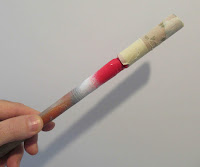The wind was just starting to pick up at about 7:30 a.m. I decided to first launch the MicroMaxx model to judge the launch rod angle.
I can't believe I actually captured a MicroMaxx launch! In the next burst series picture the
MMX BIRD BIRD ZERO was out of frame.
I tried to launch this one last time out, but the batteries were too old. With new batteries installed, ignition seemed faster. Estimated altitude is not what the Semroc face card claims, but closer to 60 feet.

A good second flier is my old Quest
VIPER with a Chinese A6-4 motor.
Under the kite tail streamer, it bounced when it hit the ground. I thought there might be a cracked fin but no damage.
Estimated altitude was 250'.
This one was built for fun in one evening. A blog build will be featured later on.
Except for an Odd'l BT-20 heavy wall internal tube, most all of the
HIGH ROLLER was made from toilet paper tubes. A tip of the hat to Jim Flis, the tubes were stacked at slight angles like the Acme Spitfire.
It was stable with a Estes B6-4, altitude was around 250'.
At ejection the new shock cord broke!
Considering the body nosed in and dug itself into the ground, it's actually in pretty good shape.
On the right is the nose cone and parachute drifting away. I looked but couldn't find it in my neighborhood.
Time to save more toilet paper rolls for a re-build!

The first launch of an upcoming blog build,
The Quest
FUTURE LAUNCH VEHICLE.
With a few small strength modifications it seemed heavy, I should have went with a B6-2 instead of today's B6-4.
Altitude was about 250'. No damage on recovery.

Last launched was the Centuri
ARGUS clone with an Estes B6-4.
Good thing I reefed the upper section parachute or it might have landed in the street. Perfect launch to about 275'.
Five launched, one lost T.P. rolled nose cone and parachute on the High Roller. Almost a perfect start for a Saturday.




















































